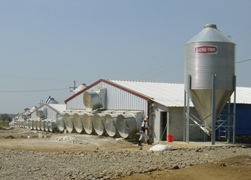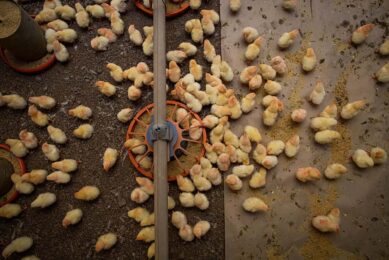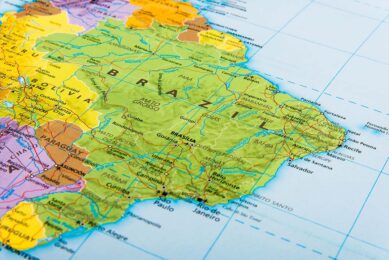Latin America on a growth path

With its economy growing fast, and its currency gaining ground, poultry exports from Brazil are faltering. So will Argentina be able to pick up the baton? A look at the scene in some major markets in Latin America.
By Patrick Knight, Sao Paulo, Brazil
Favoured by a climate particularly suitable for growing soya and maize, the leading ingredients fed to poultry, with plentiful supplies of water and with relatively small populations, several countries in Latin America began to make an impact on the world poultry scene about 20 years ago. The surge in production and exports, notably by Brazil, has subsequently transformed world trade in poultry. But after two decades of stagnation, which paradoxically encouraged exports, the Brazilian economy began to grow fast five years ago, which has resulted in domestic demand for chicken increasing dramatically.
Exporting from Brazil is also now handicapped by the strength of the country’s currency, the real. So a new phase which could favour other countries in the region, notably Argentina, may have begun.Five countries in Latin America for which detailed statistics are published by USDA, Brazil, Mexico, Colombia, Argentina and Venezuela, produced a total of about 4.2 million tonnes of chicken in 1990, a year when a total of 27.4 million tonnes was produced worldwide. Already by far the leader, Brazil produced 2.4 million tonnes, Mexico almost one million tonnes and the other three produced almost 800,000 tonnes between them.
Three of the five countries, Brazil, Argentina and Venezuela, exported 326,000 tonnes of chicken in 1990, a year when a total of 2.3 million tonnes was traded worldwide. Ten years later, the same five countries plus Chile, produced 10.5 million tonnes, and between them exported 950,000 tonnes.
Whole bird export
Brazil’s very first chicken exports, which occurred in the early 1970s, went to the Middle East, still the country’s leading market in terms of volume, although not in revenues. Most of the meat sold to countries in the region has until very recently been overwhelmingly of whole birds, which cost significantly less than the sophisticated cuts sold to countries in Europe and Asia. Notably to Japan, which pays the highest prices of all for the meat it consumes. Another factor which helped give Brazil the edge over its competitors, was that its economy has not performed as well as that of most of its neighbours until recently.
Until about 10 years ago, inflation in Brazil was extremely high, a phenomena which resulted in the value of the Brazilian currency remaining low. The weak real made exporting attractive, as when converted into local currency, in which virtually all farmers and processors costs are incurred, the revenue from exports meant selling abroad was up to 50% more profitable than selling the same goods on the domestic market. Less than 12% of Brazil’s total production was exported in the 1990s but since then, the share sold abroad has occasionally exceeded 30%.
Foreign investors
The situation has changed dramatically recently, the Brazilian economy has grown by an average of about 5% each year, helping make the country a favourite destination for foreign investors. One result of this has been that the Brazilian real, has risen strongly against the US dollar and other currencies. The strong real has had two negative effects for exporters. One is that the products Brazil exports have become less competitive than previously, the other is that revenues from exports buy far less in Brazil than before.
While exporting has become less attractive and lucrative, the Brazilian economy has been performing well enough to allow the disposable incomes of about 30 million people to increase sufficiently to allow them to buy much more in the past few years. This has included more higher value foods, including chicken, the lowest cost meat. Per capita consumption of chicken in Brazil rose from 35 kgs in 2005, to a massive 45 kgs last year, one of the highest in the world. As well as this, much of the extra chicken is consumed in the form of high value processed goods, rather than basic items. Several large exporters no longer bother to sell whole birds on the domestic market.
Feed prices risen
An additional problem has been that the cost of both maize and soya meal, which form 80% of the feed given to chickens in Brazil, has risen greatly in the past few years. Mainly because of increased demand for feed grains from China and other developing countries.
The rise in the price of feed, unlike the problem of the strong currency and the strengthening of domestic demand, has affected all chicken producing countries, however, so does not directly reduce the competitiveness of Brazilian chicken.
The only way to overcome the present difficulties, is for Brazilian exporters to raise prices. They have managed to do this partially, at least, although exporters have met resistance in some markets, so exporting is stagnant at the moment.
The gap between the price of exports and of the meat sold on the domestic market has narrowed sharply in the past few years, and rather than an extra 10% now being exported each year, which used to be the case, much less additional meat will be shipped this year.
Argentina benefiting
Because the Argentine peso is now far weaker than the Brazilian real, Argentina is managing to sell chicken to many markets previously closed to it, notably the EU, China and Japan. It remains to be seen whether the poultry industry in Argentina will be able to increase its penetration of markets previously dominated by Brazil.
Like Brazil, Argentina is a leading producer of maize and soya, so apart from the influence of the exchange rate, production costs there are similar to those in Brazil. The major difference between Brazil and Argentina, is that while there are 200 million consumers in Brazil, there are only about 40 million in Argentina. The price of beef, which used to be low enough to permit each Argentine to eat 70 kgs of beef or more each year has now increased, with the result that “only” 60 kgs are eaten per capita, double the amount consumed in Brazil.
Chicken popular
As a result of high beef prices, a growing number of people in Argentina also now prefer chicken, which normally costs half as much as beef. The result has been that per capita consumption of chicken in Argentina has risen from 24 kgs in 2000 to 34 kgs last year. Of considerable concern to investors, whose capital would be needed if production in Argentina is to be raised from the present 1.6 million tonnes to two or three million tonnes, is that the country’s economy has been badly managed in recent years.
Argentina is now experiencing inflation of more than 20% a year, compared with less than 6% in Brazil. To hold down the cost of utilities such as electricity, gas, motor fuels and fares, as well as those of basic goods, including beef and other foods, prices are tightly controlled. This policy can only be applied successfully for a relatively short time, however, as with low or non-existent profits, no investment occurs and things begin to run short. This is already happening in Argentina, where power cuts are now a frequent occurrence. Sooner or later, refusing to allow prices to rise will result in severe economic problems. So although the poultry industry in Argentina could in theory challenge that of Brazil, it is unlikely to do so for some time, as the investments needed are unlikely to be forthcoming.
Chile Nafta member
Chile is not a large scale producer and although exports have increased from virtually nothing prior to 2002, they are still a relatively modest 80,000 tonnes. One reason for Chile’s creditable export performance, is that unlike the other Latin American countries, Chile is a member of the US sponsored Free Trade Area for North America, Nafta, to which Mexico the US and Canada also belong. Unlike Brazil and Argentina, Chile can export freely to these important markets, particularly to Mexico, one of the world’s leading importers and which imported about 550,000 tonnes last year. Only Russia, Japan and all the EU member countries together imported more chicken than Mexico did last year.
Chile, which produced a modest 540,000 tonnes of chicken last year, exported 80,000 tonnes of high value products. To substitute what was exported, 70,000 tonnes of lower value products were imported last year from Brazil or Argentina. This business is very profitable, but it is unlikely to encourage much new investment in Chile, not an important producer of food grains, and therefore a higher cost producer than Brazil or Argentina.
Mexico, Colombia & Venezuela
These three countries have almost ceased exporting chicken in recent years, mainly because consumption has increased far faster than production. Colombia, unlike Brazil and Argentina, is not an important producer of maize or soya, so some feed grains are normally imported. Colombia nevertheless increased output from just over 600,000 tonnes in 2000 to more than a million tonnes last year. But because per capita consumption rose from about 16 kgs in 2000 to 24 kgs in 2010, Colombia had to import 36,000 tonnes last year, compared with 11,000 tonnes in 2000.
The situation in Venezuela is much more serious, as with per capita consumption now averaging about 30 kgs, well above the regional average of about 26 kgs. The amount of chicken produced in the country slipped from a peak of 900,000 tonnes in year 2000 to only 650,000 tonnes in 2010. To gain the support of electors, the strongly nationalist government has held down prices of basic foods and attempted to force farmers to sell at prices often below cost. This has caused many farmers to abandon their farms, and has forced import to rise from virtually nil in 2000, to a peak of 350,000 tonnes in 2006. Shortages have also meant that Venezuela has ceased to export any chicken.
Mexico, where per capita consumption rose from 21.5 kgs in 2000 to almost 30 kgs last year but which has only been able to increase production from 1.9 million tonnes ten years ago to 2.8 million tonnes last year, has also seen imports increase from just over 200,000 tonnes in year 2000, to 550,000 tonnes last year.
Join 31,000+ subscribers
Subscribe to our newsletter to stay updated about all the need-to-know content in the poultry sector, three times a week. Beheer
Beheer








 WP Admin
WP Admin  Bewerk bericht
Bewerk bericht